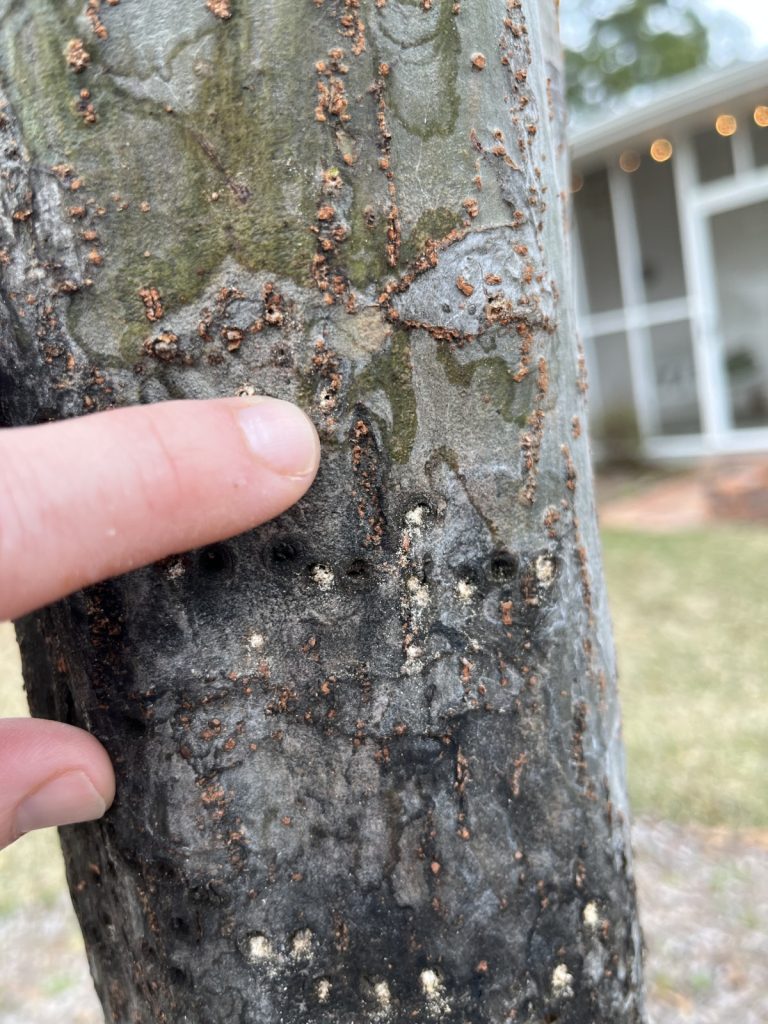It looks like we are seeing the first flight. Dr. Barman has seen good hits on new trials in Ware County and Brooks County. East Georgia is having consistent flights now (February 20th).There are two particular groups of pecan growers that need to be aware of ambrosia beetle flights:
- Small – medium size orchards
- Pecan trees under 4 years old


In the 2015 – 2016 era, the state of Georgia did have higher ambrosia beetle outbreaks. Because trees sold from ornamental tree nurseries are vulnerable to ambrosia beetle attacks, we can be attuned to statewide outbreaks. Remember, our pecan trees are considered vulnerable in their first few years of growth. The ambrosia beetles live in wooded areas and respond to stress chemicals released from newly planted trees.
Whether we see a large outbreak or not, ambrosia beetle attacks of young pecan trees will occur at some extend on newly planted pecan trees. We are traveling around the state at this time seeing everyone at county pecan updates. New entomologist Dr. Apurba Barman, has answered questions from everyone now about spraying for beetles with our temperatures increasing. Female beetles can fly as soon as air temperatures hit 60 F. Our temperatures have been up and down, but middle February generally sees first flights in deep South Georgia.
Ambrosia Beetle Management
The best management approach is this:
- Set ambrosia beetle traps to determine first flight
- Once hits are observed on traps, scout pecan trees
- Spray pecan trees with bifinthrin or permethrin every 7 – 10 days
- Continue monitoring traps adding ethylene into drill holes once a week
The reason we begin with traps is because spraying trees is not as convenient as it sounds. In our original research of control methods, we found ambrosia beetles like to go down into the tree guards. This means you either 1) take off the tree guards to spray with an airblast sprayer or you 2) use a hand wand sprayer to spray trees individually making sure to spray down into the tree guard.
This is not something you want to do before you know when beetles are flying and how much beetle pressure is on the farm. The next question asked is is why do we spray so often?
Spray Interval Research
In our original management research, we compared painting trees with white latex paint with spraying pyrethroids. We chose 7-day interval applications knowing the pyrethroid would not stay on the tree long. Statistically, research showed the best options was either 1) applying pyrethoird insecticide to painted trees or 2) spraying pyrethroid at 7 day intervals.
Knowing seven-day interval spray is a lot for growers to come back and spray individual tree, Dr. Apurba Barman and I are going to test if this interval can be extended to 14 days instead of 7-days. We are also not sure whether we need to use full labeled rate or pyrethroid or lower rate can do the job. Through this particular experiment, we are also going to evaluate how low and high rate of pyrethroid application impact ambrosia beetle control. The primary goal of this experiment is to reduce use of insecticide as well as burden of spraying the young trees so frequently.
Written by: Dr. Apurba Barman & Andrew Sawyer
